GBS - CST 639 Healthcare Risk Management: Risk Mitigation Strategies
VerifiedAdded on 2023/06/03
|9
|1433
|309
Case Study
AI Summary
This case study provides a comprehensive overview of healthcare risk management, beginning with a definition of risk and its importance in the healthcare industry. It identifies five hazardous domains requiring focus: cyber risk, healthcare infections, telemedicine, violent incidents, and alarm fatigue. The study discusses the ISO 31000 Risk Management Framework and presents questions for identifying potential workplace risks. It also highlights clinical safety targets identified by the Agency for Healthcare Research and Quality (AHRQ), focusing on patient handling and security. A retrospective analysis of medical errors is conducted, and the BowTie Risk Management Methodology is explained, detailing potential errors, causes, barriers, and consequences. The assignment emphasizes the importance of effective risk management in ensuring patient safety and organizational stability, with references to support the analysis and recommendations.
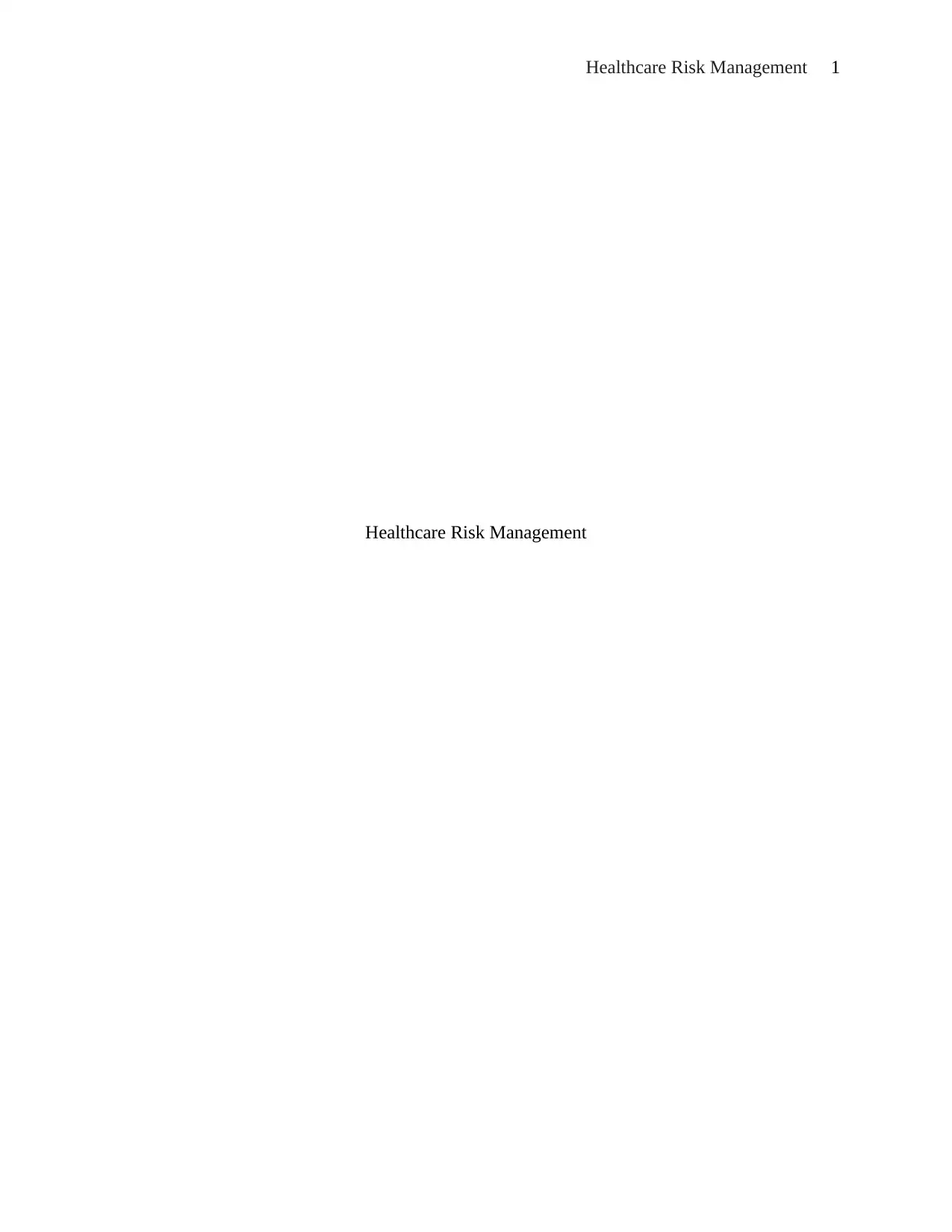
Healthcare Risk Management 1
Healthcare Risk Management
Healthcare Risk Management
Paraphrase This Document
Need a fresh take? Get an instant paraphrase of this document with our AI Paraphraser
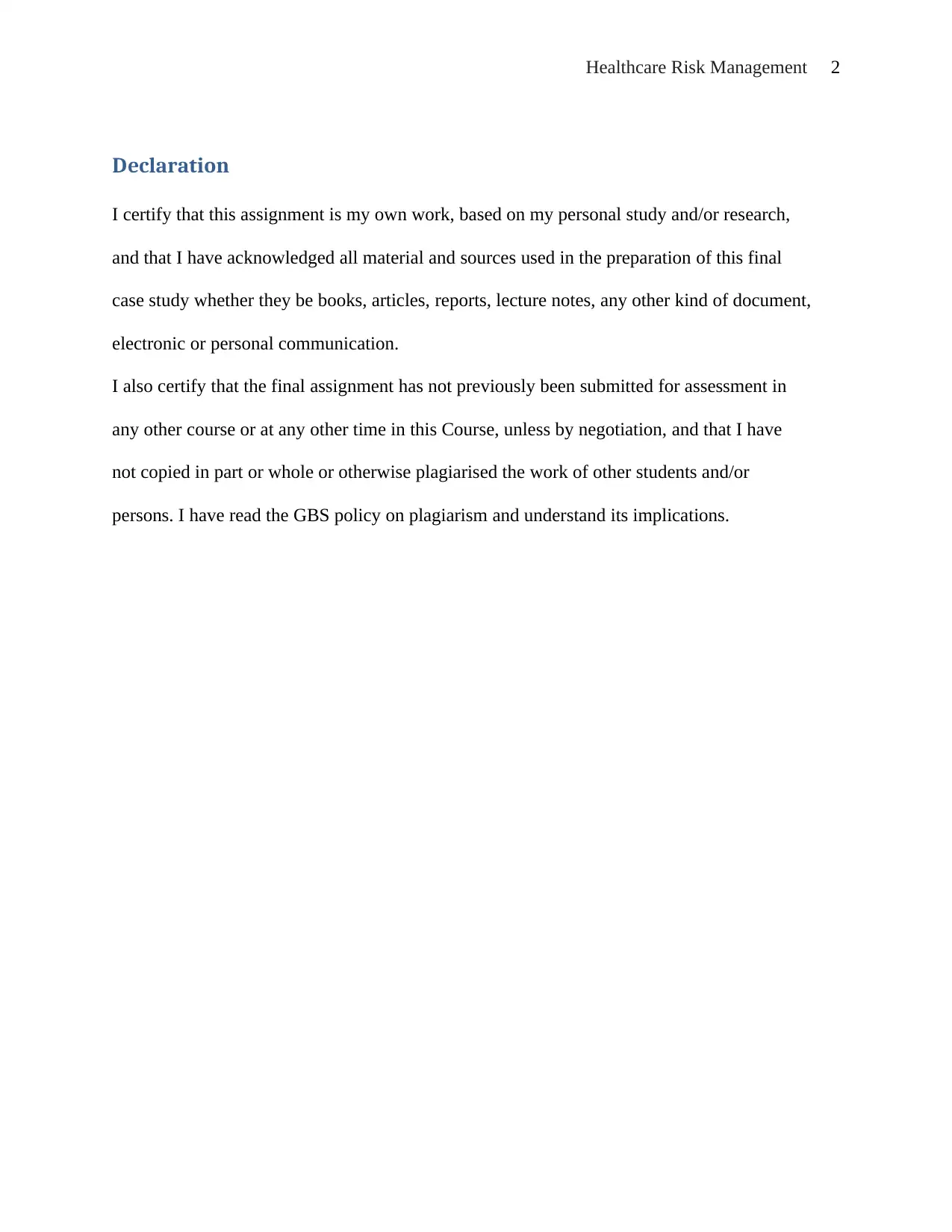
Healthcare Risk Management 2
Declaration
I certify that this assignment is my own work, based on my personal study and/or research,
and that I have acknowledged all material and sources used in the preparation of this final
case study whether they be books, articles, reports, lecture notes, any other kind of document,
electronic or personal communication.
I also certify that the final assignment has not previously been submitted for assessment in
any other course or at any other time in this Course, unless by negotiation, and that I have
not copied in part or whole or otherwise plagiarised the work of other students and/or
persons. I have read the GBS policy on plagiarism and understand its implications.
Declaration
I certify that this assignment is my own work, based on my personal study and/or research,
and that I have acknowledged all material and sources used in the preparation of this final
case study whether they be books, articles, reports, lecture notes, any other kind of document,
electronic or personal communication.
I also certify that the final assignment has not previously been submitted for assessment in
any other course or at any other time in this Course, unless by negotiation, and that I have
not copied in part or whole or otherwise plagiarised the work of other students and/or
persons. I have read the GBS policy on plagiarism and understand its implications.
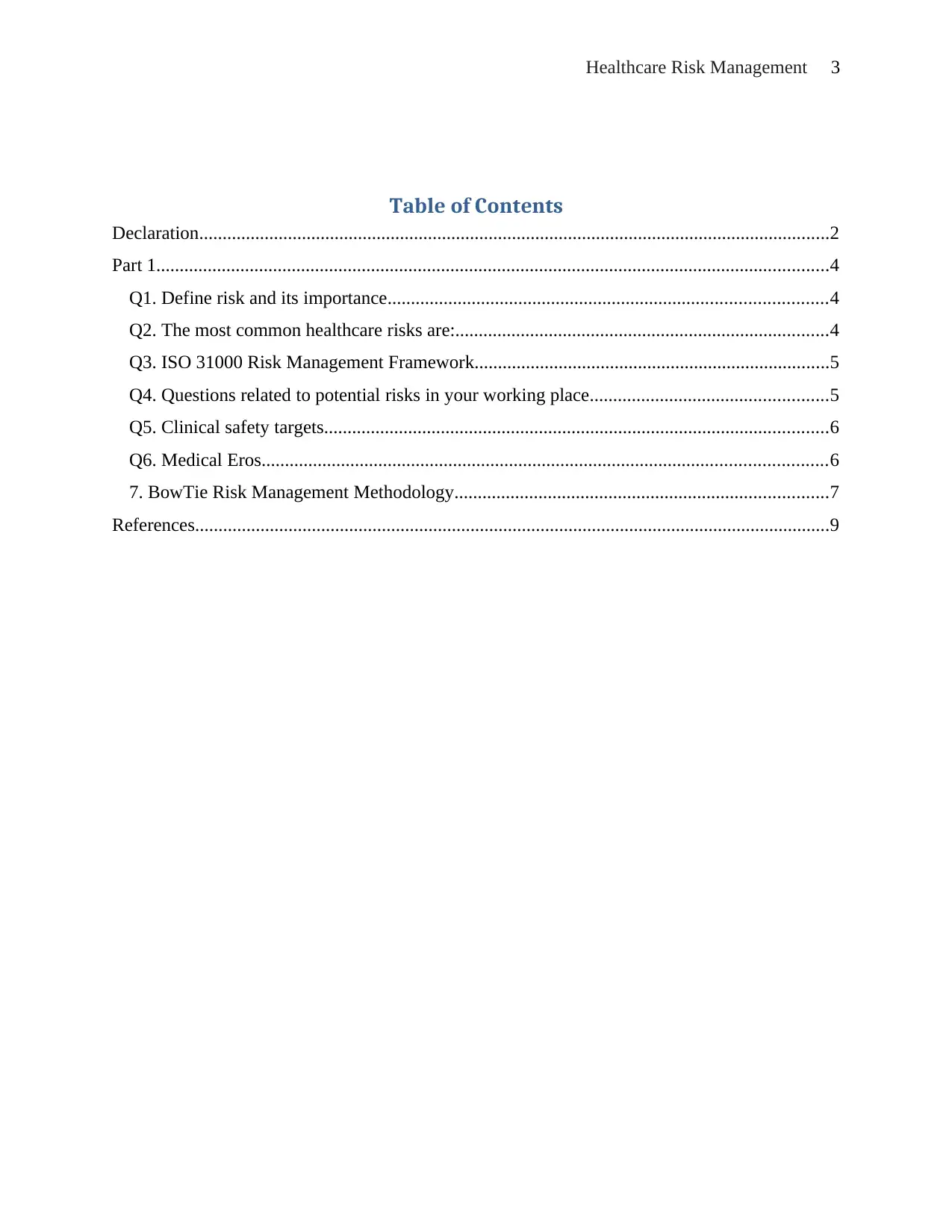
Healthcare Risk Management 3
Table of Contents
Declaration.......................................................................................................................................2
Part 1................................................................................................................................................4
Q1. Define risk and its importance..............................................................................................4
Q2. The most common healthcare risks are:................................................................................4
Q3. ISO 31000 Risk Management Framework............................................................................5
Q4. Questions related to potential risks in your working place...................................................5
Q5. Clinical safety targets............................................................................................................6
Q6. Medical Eros.........................................................................................................................6
7. BowTie Risk Management Methodology................................................................................7
References........................................................................................................................................9
Table of Contents
Declaration.......................................................................................................................................2
Part 1................................................................................................................................................4
Q1. Define risk and its importance..............................................................................................4
Q2. The most common healthcare risks are:................................................................................4
Q3. ISO 31000 Risk Management Framework............................................................................5
Q4. Questions related to potential risks in your working place...................................................5
Q5. Clinical safety targets............................................................................................................6
Q6. Medical Eros.........................................................................................................................6
7. BowTie Risk Management Methodology................................................................................7
References........................................................................................................................................9
⊘ This is a preview!⊘
Do you want full access?
Subscribe today to unlock all pages.

Trusted by 1+ million students worldwide
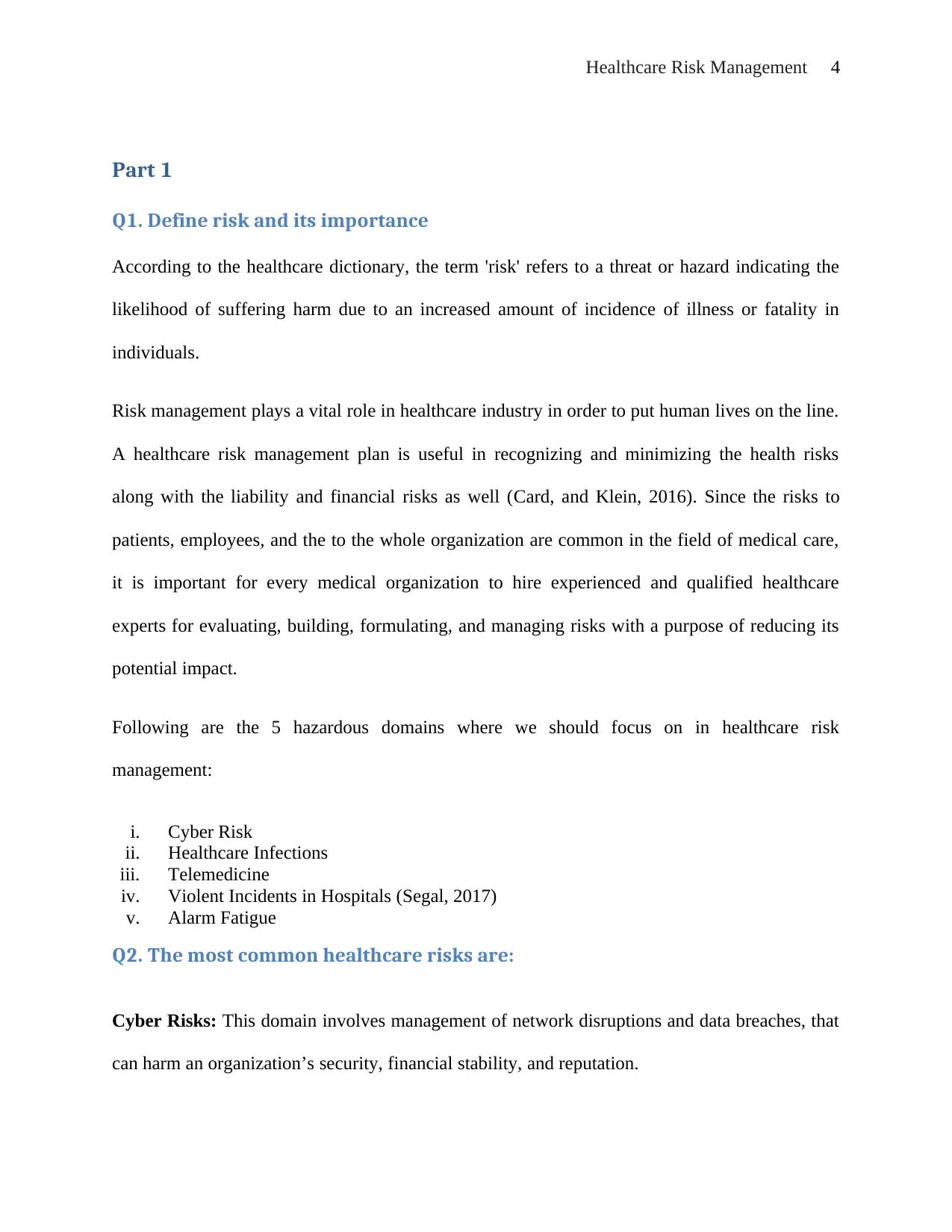
Healthcare Risk Management 4
Part 1
Q1. Define risk and its importance
According to the healthcare dictionary, the term 'risk' refers to a threat or hazard indicating the
likelihood of suffering harm due to an increased amount of incidence of illness or fatality in
individuals.
Risk management plays a vital role in healthcare industry in order to put human lives on the line.
A healthcare risk management plan is useful in recognizing and minimizing the health risks
along with the liability and financial risks as well (Card, and Klein, 2016). Since the risks to
patients, employees, and the to the whole organization are common in the field of medical care,
it is important for every medical organization to hire experienced and qualified healthcare
experts for evaluating, building, formulating, and managing risks with a purpose of reducing its
potential impact.
Following are the 5 hazardous domains where we should focus on in healthcare risk
management:
i. Cyber Risk
ii. Healthcare Infections
iii. Telemedicine
iv. Violent Incidents in Hospitals (Segal, 2017)
v. Alarm Fatigue
Q2. The most common healthcare risks are:
Cyber Risks: This domain involves management of network disruptions and data breaches, that
can harm an organization’s security, financial stability, and reputation.
Part 1
Q1. Define risk and its importance
According to the healthcare dictionary, the term 'risk' refers to a threat or hazard indicating the
likelihood of suffering harm due to an increased amount of incidence of illness or fatality in
individuals.
Risk management plays a vital role in healthcare industry in order to put human lives on the line.
A healthcare risk management plan is useful in recognizing and minimizing the health risks
along with the liability and financial risks as well (Card, and Klein, 2016). Since the risks to
patients, employees, and the to the whole organization are common in the field of medical care,
it is important for every medical organization to hire experienced and qualified healthcare
experts for evaluating, building, formulating, and managing risks with a purpose of reducing its
potential impact.
Following are the 5 hazardous domains where we should focus on in healthcare risk
management:
i. Cyber Risk
ii. Healthcare Infections
iii. Telemedicine
iv. Violent Incidents in Hospitals (Segal, 2017)
v. Alarm Fatigue
Q2. The most common healthcare risks are:
Cyber Risks: This domain involves management of network disruptions and data breaches, that
can harm an organization’s security, financial stability, and reputation.
Paraphrase This Document
Need a fresh take? Get an instant paraphrase of this document with our AI Paraphraser
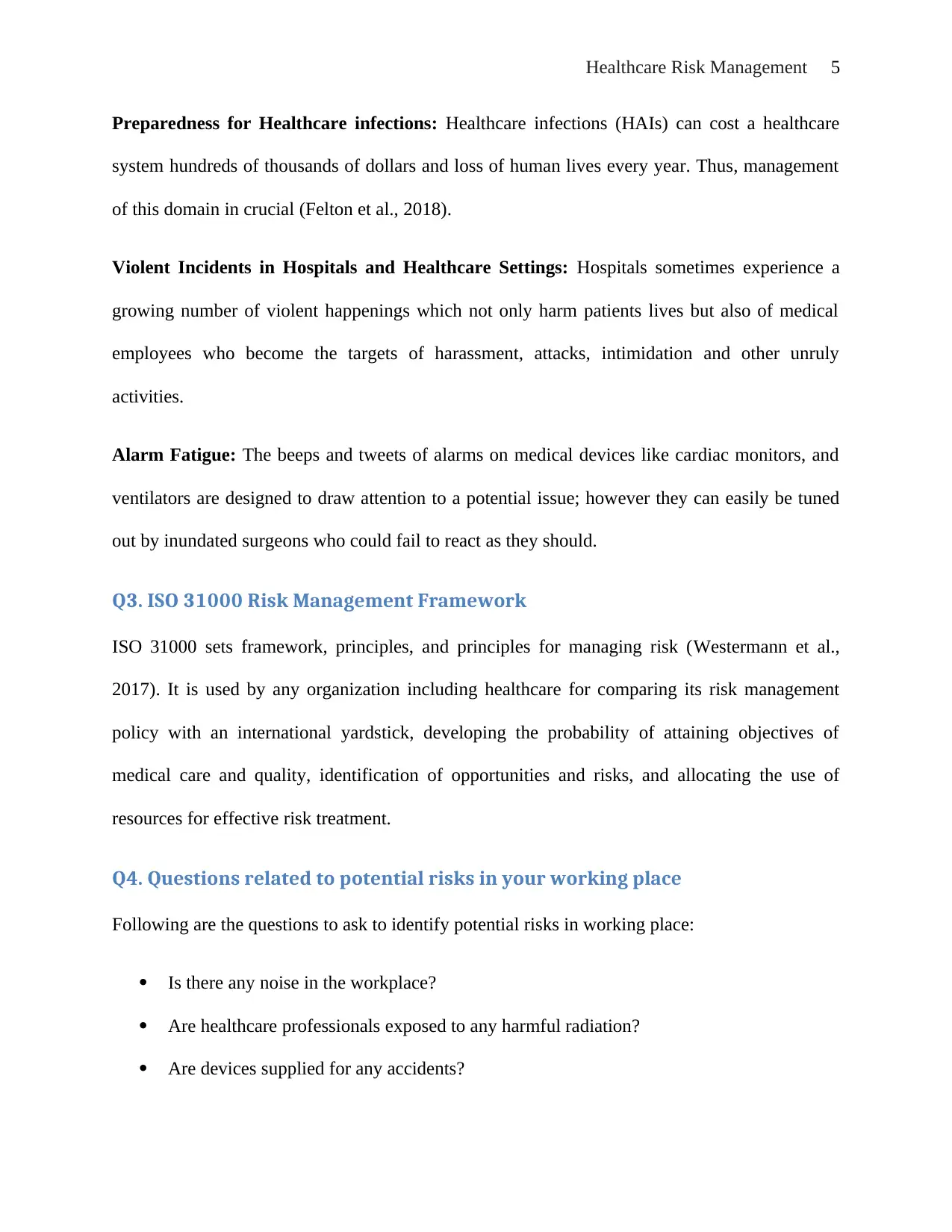
Healthcare Risk Management 5
Preparedness for Healthcare infections: Healthcare infections (HAIs) can cost a healthcare
system hundreds of thousands of dollars and loss of human lives every year. Thus, management
of this domain in crucial (Felton et al., 2018).
Violent Incidents in Hospitals and Healthcare Settings: Hospitals sometimes experience a
growing number of violent happenings which not only harm patients lives but also of medical
employees who become the targets of harassment, attacks, intimidation and other unruly
activities.
Alarm Fatigue: The beeps and tweets of alarms on medical devices like cardiac monitors, and
ventilators are designed to draw attention to a potential issue; however they can easily be tuned
out by inundated surgeons who could fail to react as they should.
Q3. ISO 31000 Risk Management Framework
ISO 31000 sets framework, principles, and principles for managing risk (Westermann et al.,
2017). It is used by any organization including healthcare for comparing its risk management
policy with an international yardstick, developing the probability of attaining objectives of
medical care and quality, identification of opportunities and risks, and allocating the use of
resources for effective risk treatment.
Q4. Questions related to potential risks in your working place
Following are the questions to ask to identify potential risks in working place:
Is there any noise in the workplace?
Are healthcare professionals exposed to any harmful radiation?
Are devices supplied for any accidents?
Preparedness for Healthcare infections: Healthcare infections (HAIs) can cost a healthcare
system hundreds of thousands of dollars and loss of human lives every year. Thus, management
of this domain in crucial (Felton et al., 2018).
Violent Incidents in Hospitals and Healthcare Settings: Hospitals sometimes experience a
growing number of violent happenings which not only harm patients lives but also of medical
employees who become the targets of harassment, attacks, intimidation and other unruly
activities.
Alarm Fatigue: The beeps and tweets of alarms on medical devices like cardiac monitors, and
ventilators are designed to draw attention to a potential issue; however they can easily be tuned
out by inundated surgeons who could fail to react as they should.
Q3. ISO 31000 Risk Management Framework
ISO 31000 sets framework, principles, and principles for managing risk (Westermann et al.,
2017). It is used by any organization including healthcare for comparing its risk management
policy with an international yardstick, developing the probability of attaining objectives of
medical care and quality, identification of opportunities and risks, and allocating the use of
resources for effective risk treatment.
Q4. Questions related to potential risks in your working place
Following are the questions to ask to identify potential risks in working place:
Is there any noise in the workplace?
Are healthcare professionals exposed to any harmful radiation?
Are devices supplied for any accidents?
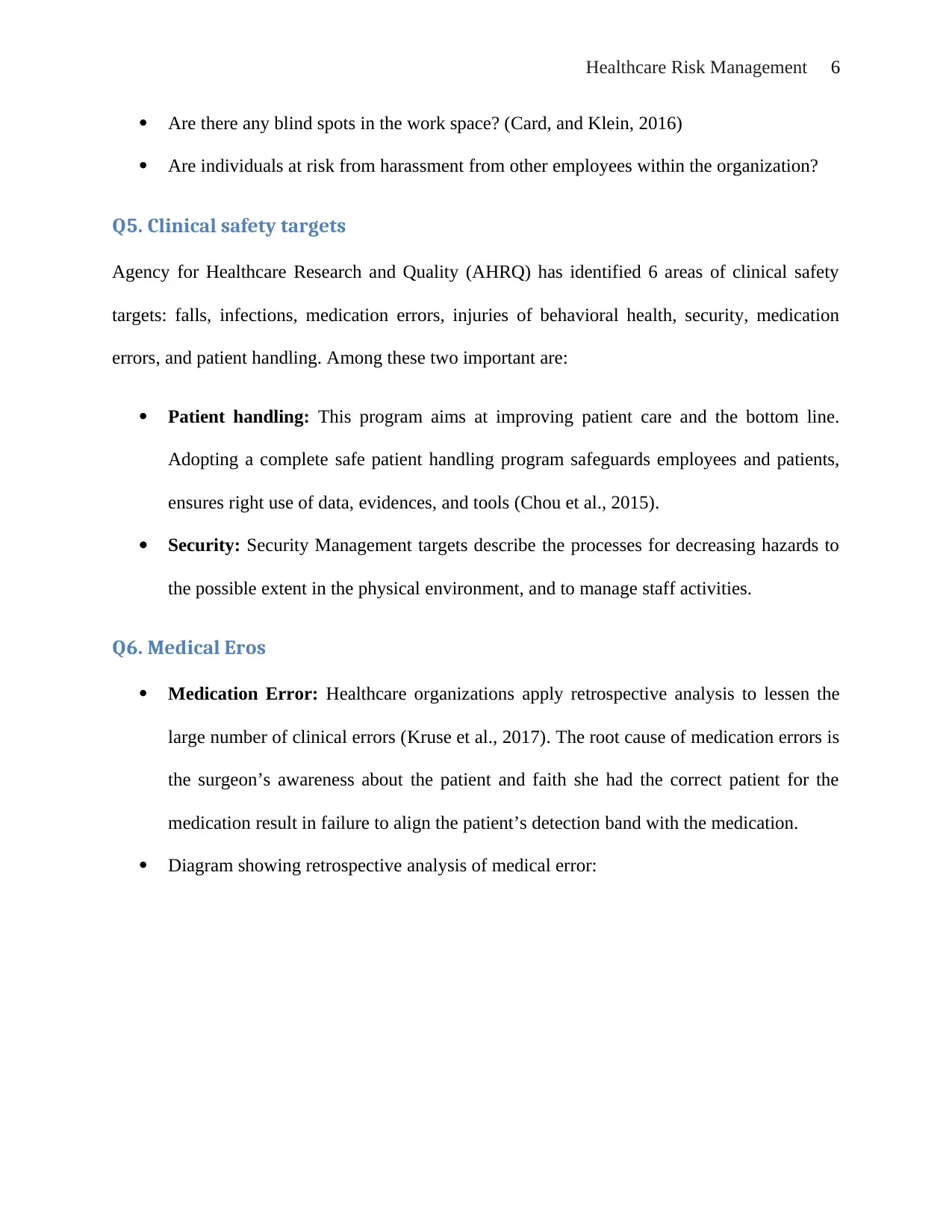
Healthcare Risk Management 6
Are there any blind spots in the work space? (Card, and Klein, 2016)
Are individuals at risk from harassment from other employees within the organization?
Q5. Clinical safety targets
Agency for Healthcare Research and Quality (AHRQ) has identified 6 areas of clinical safety
targets: falls, infections, medication errors, injuries of behavioral health, security, medication
errors, and patient handling. Among these two important are:
Patient handling: This program aims at improving patient care and the bottom line.
Adopting a complete safe patient handling program safeguards employees and patients,
ensures right use of data, evidences, and tools (Chou et al., 2015).
Security: Security Management targets describe the processes for decreasing hazards to
the possible extent in the physical environment, and to manage staff activities.
Q6. Medical Eros
Medication Error: Healthcare organizations apply retrospective analysis to lessen the
large number of clinical errors (Kruse et al., 2017). The root cause of medication errors is
the surgeon’s awareness about the patient and faith she had the correct patient for the
medication result in failure to align the patient’s detection band with the medication.
Diagram showing retrospective analysis of medical error:
Are there any blind spots in the work space? (Card, and Klein, 2016)
Are individuals at risk from harassment from other employees within the organization?
Q5. Clinical safety targets
Agency for Healthcare Research and Quality (AHRQ) has identified 6 areas of clinical safety
targets: falls, infections, medication errors, injuries of behavioral health, security, medication
errors, and patient handling. Among these two important are:
Patient handling: This program aims at improving patient care and the bottom line.
Adopting a complete safe patient handling program safeguards employees and patients,
ensures right use of data, evidences, and tools (Chou et al., 2015).
Security: Security Management targets describe the processes for decreasing hazards to
the possible extent in the physical environment, and to manage staff activities.
Q6. Medical Eros
Medication Error: Healthcare organizations apply retrospective analysis to lessen the
large number of clinical errors (Kruse et al., 2017). The root cause of medication errors is
the surgeon’s awareness about the patient and faith she had the correct patient for the
medication result in failure to align the patient’s detection band with the medication.
Diagram showing retrospective analysis of medical error:
⊘ This is a preview!⊘
Do you want full access?
Subscribe today to unlock all pages.

Trusted by 1+ million students worldwide
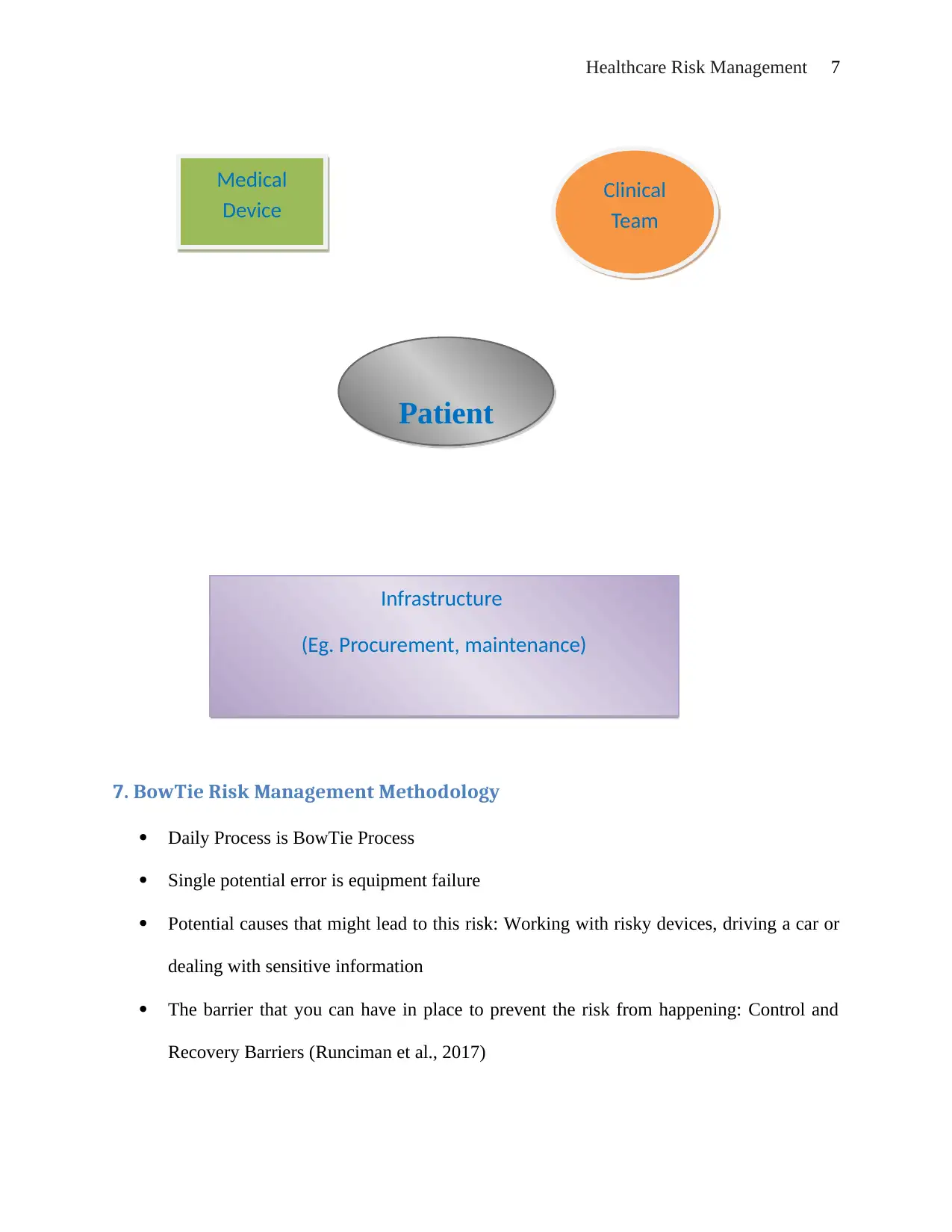
Healthcare Risk Management 7
7. BowTie Risk Management Methodology
Daily Process is BowTie Process
Single potential error is equipment failure
Potential causes that might lead to this risk: Working with risky devices, driving a car or
dealing with sensitive information
The barrier that you can have in place to prevent the risk from happening: Control and
Recovery Barriers (Runciman et al., 2017)
Medical
Device Clinical
Team
Patient
Infrastructure
(Eg. Procurement, maintenance)
7. BowTie Risk Management Methodology
Daily Process is BowTie Process
Single potential error is equipment failure
Potential causes that might lead to this risk: Working with risky devices, driving a car or
dealing with sensitive information
The barrier that you can have in place to prevent the risk from happening: Control and
Recovery Barriers (Runciman et al., 2017)
Medical
Device Clinical
Team
Patient
Infrastructure
(Eg. Procurement, maintenance)
Paraphrase This Document
Need a fresh take? Get an instant paraphrase of this document with our AI Paraphraser
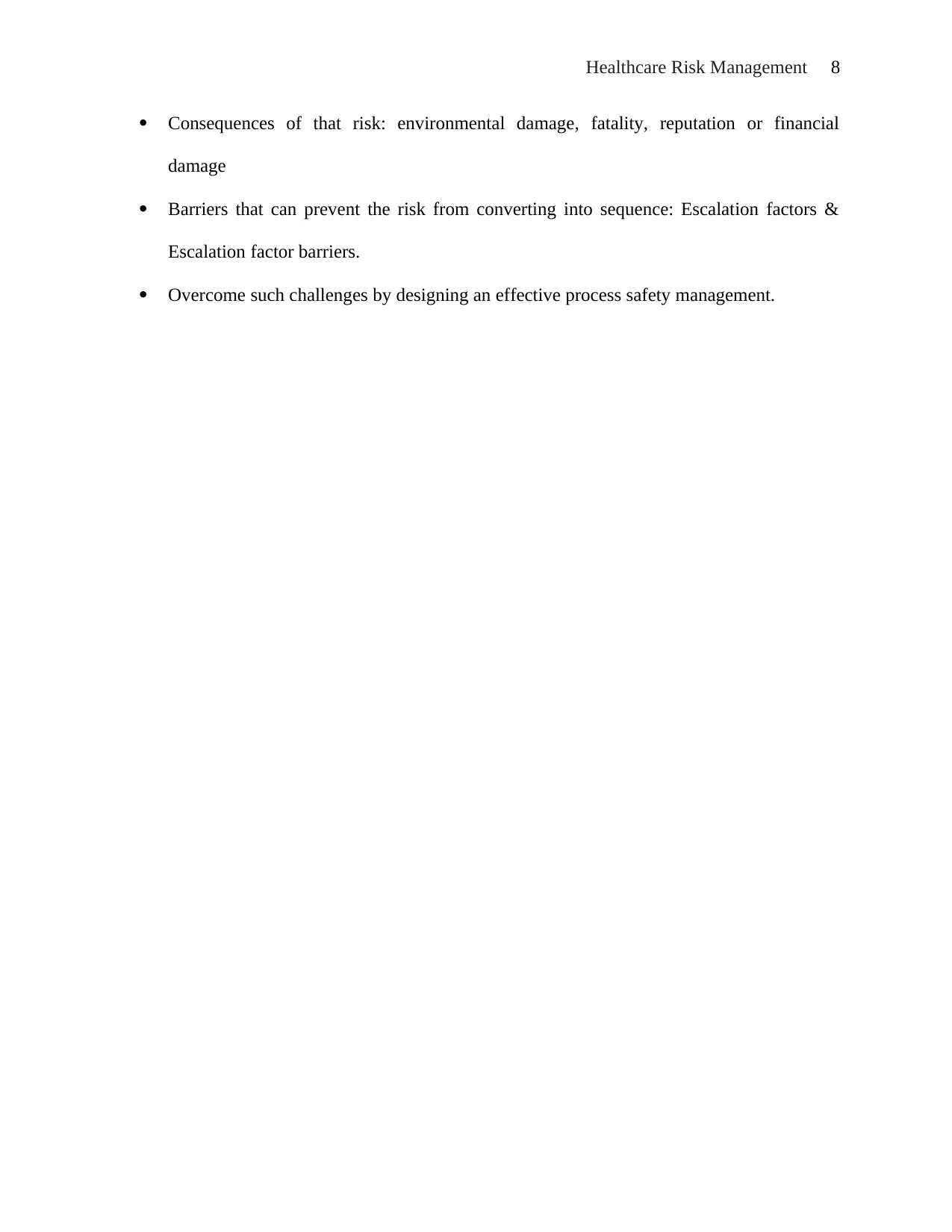
Healthcare Risk Management 8
Consequences of that risk: environmental damage, fatality, reputation or financial
damage
Barriers that can prevent the risk from converting into sequence: Escalation factors &
Escalation factor barriers.
Overcome such challenges by designing an effective process safety management.
Consequences of that risk: environmental damage, fatality, reputation or financial
damage
Barriers that can prevent the risk from converting into sequence: Escalation factors &
Escalation factor barriers.
Overcome such challenges by designing an effective process safety management.
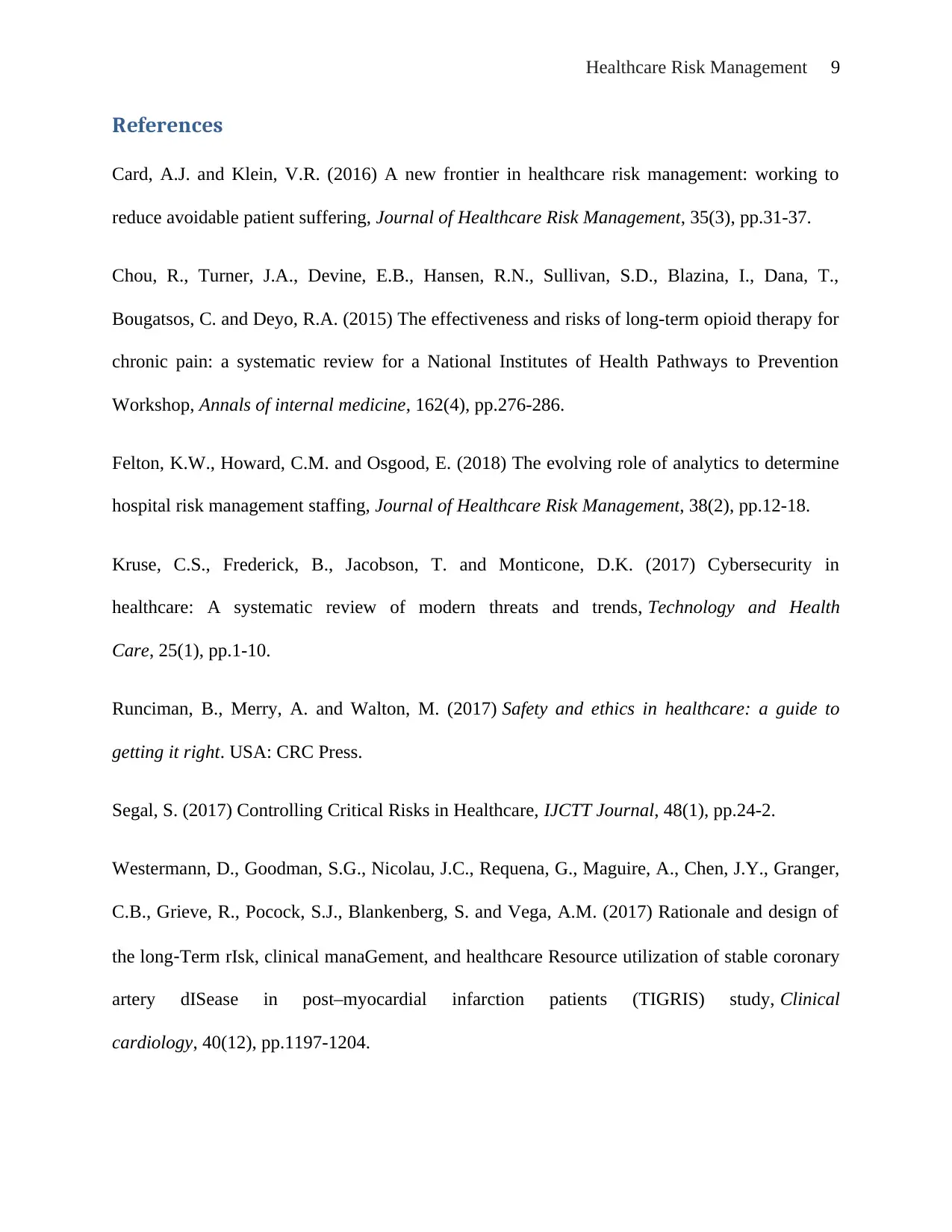
Healthcare Risk Management 9
References
Card, A.J. and Klein, V.R. (2016) A new frontier in healthcare risk management: working to
reduce avoidable patient suffering, Journal of Healthcare Risk Management, 35(3), pp.31-37.
Chou, R., Turner, J.A., Devine, E.B., Hansen, R.N., Sullivan, S.D., Blazina, I., Dana, T.,
Bougatsos, C. and Deyo, R.A. (2015) The effectiveness and risks of long-term opioid therapy for
chronic pain: a systematic review for a National Institutes of Health Pathways to Prevention
Workshop, Annals of internal medicine, 162(4), pp.276-286.
Felton, K.W., Howard, C.M. and Osgood, E. (2018) The evolving role of analytics to determine
hospital risk management staffing, Journal of Healthcare Risk Management, 38(2), pp.12-18.
Kruse, C.S., Frederick, B., Jacobson, T. and Monticone, D.K. (2017) Cybersecurity in
healthcare: A systematic review of modern threats and trends, Technology and Health
Care, 25(1), pp.1-10.
Runciman, B., Merry, A. and Walton, M. (2017) Safety and ethics in healthcare: a guide to
getting it right. USA: CRC Press.
Segal, S. (2017) Controlling Critical Risks in Healthcare, IJCTT Journal, 48(1), pp.24-2.
Westermann, D., Goodman, S.G., Nicolau, J.C., Requena, G., Maguire, A., Chen, J.Y., Granger,
C.B., Grieve, R., Pocock, S.J., Blankenberg, S. and Vega, A.M. (2017) Rationale and design of
the long‐Term rIsk, clinical manaGement, and healthcare Resource utilization of stable coronary
artery dISease in post–myocardial infarction patients (TIGRIS) study, Clinical
cardiology, 40(12), pp.1197-1204.
References
Card, A.J. and Klein, V.R. (2016) A new frontier in healthcare risk management: working to
reduce avoidable patient suffering, Journal of Healthcare Risk Management, 35(3), pp.31-37.
Chou, R., Turner, J.A., Devine, E.B., Hansen, R.N., Sullivan, S.D., Blazina, I., Dana, T.,
Bougatsos, C. and Deyo, R.A. (2015) The effectiveness and risks of long-term opioid therapy for
chronic pain: a systematic review for a National Institutes of Health Pathways to Prevention
Workshop, Annals of internal medicine, 162(4), pp.276-286.
Felton, K.W., Howard, C.M. and Osgood, E. (2018) The evolving role of analytics to determine
hospital risk management staffing, Journal of Healthcare Risk Management, 38(2), pp.12-18.
Kruse, C.S., Frederick, B., Jacobson, T. and Monticone, D.K. (2017) Cybersecurity in
healthcare: A systematic review of modern threats and trends, Technology and Health
Care, 25(1), pp.1-10.
Runciman, B., Merry, A. and Walton, M. (2017) Safety and ethics in healthcare: a guide to
getting it right. USA: CRC Press.
Segal, S. (2017) Controlling Critical Risks in Healthcare, IJCTT Journal, 48(1), pp.24-2.
Westermann, D., Goodman, S.G., Nicolau, J.C., Requena, G., Maguire, A., Chen, J.Y., Granger,
C.B., Grieve, R., Pocock, S.J., Blankenberg, S. and Vega, A.M. (2017) Rationale and design of
the long‐Term rIsk, clinical manaGement, and healthcare Resource utilization of stable coronary
artery dISease in post–myocardial infarction patients (TIGRIS) study, Clinical
cardiology, 40(12), pp.1197-1204.
⊘ This is a preview!⊘
Do you want full access?
Subscribe today to unlock all pages.

Trusted by 1+ million students worldwide
1 out of 9
Your All-in-One AI-Powered Toolkit for Academic Success.
+13062052269
info@desklib.com
Available 24*7 on WhatsApp / Email
![[object Object]](/_next/static/media/star-bottom.7253800d.svg)
Unlock your academic potential
Copyright © 2020–2025 A2Z Services. All Rights Reserved. Developed and managed by ZUCOL.
